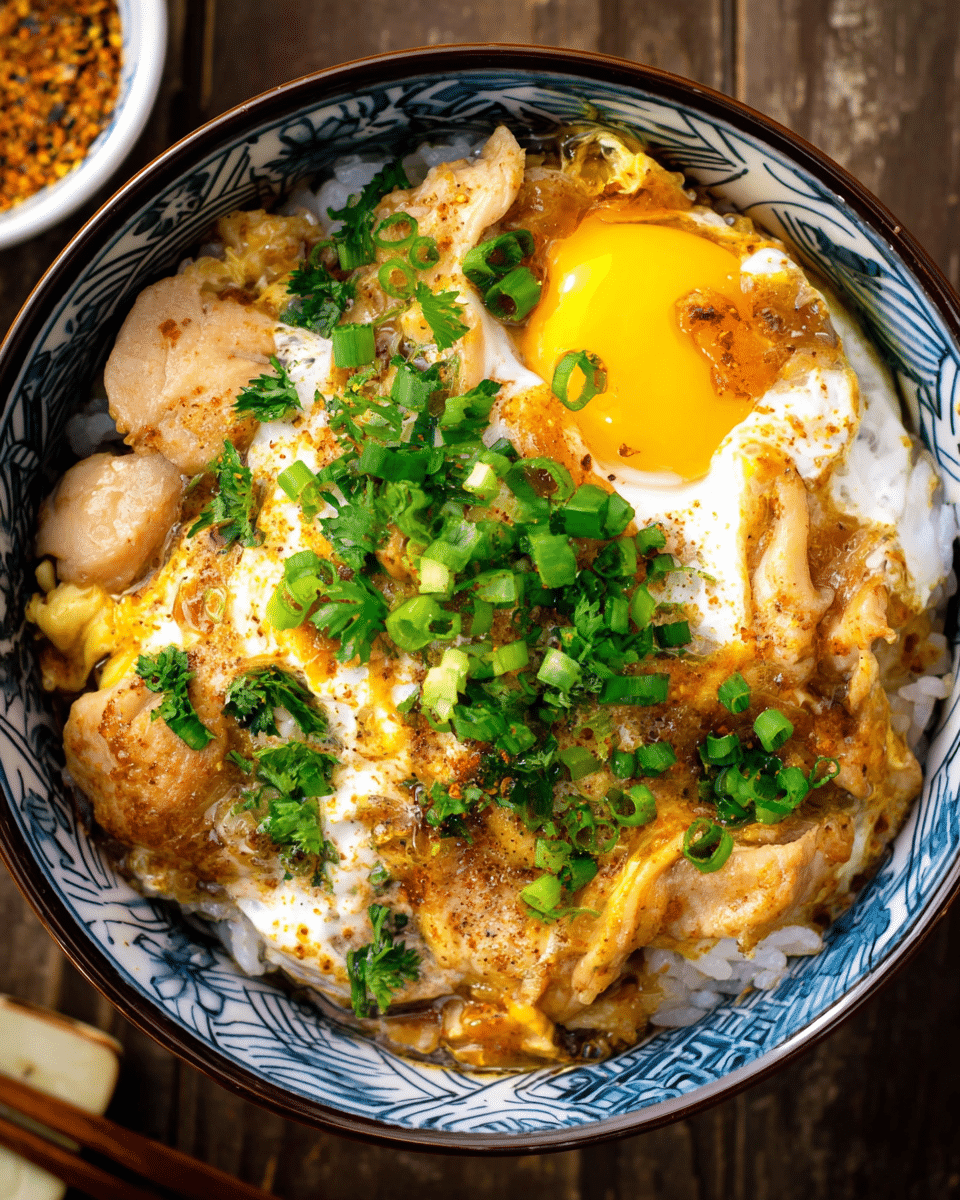Oyakodon, a Japanese comfort food, brings together tender chicken and fluffy eggs atop a bed of warm, steamed rice. The combination of rich dashi broth, savory soy sauce, and sweet mirin creates a delicate balance of flavors that is both comforting and satisfying.
This recipe is perfect for busy weeknights, offering a warm and hearty meal in just 25 minutes. With its simple yet flavorful ingredients, Oyakodon is sure to become a favorite in your home, and you can even customize it with different vegetables or toppings like pickled ginger or fresh herbs.
Full recipe:
Ingredients:
-
2 cups cooked white rice
-
1 tablespoon vegetable oil
-
2 boneless skinless chicken thighs, cut into bite-sized pieces
-
1/2 onion, thinly sliced
-
1/2 cup dashi (Japanese soup stock)
-
2 tablespoons soy sauce
-
2 tablespoons mirin
-
1 tablespoon sake
-
1 teaspoon sugar
-
2 large eggs, beaten
-
2 green onions, chopped
-
1 tablespoon fresh parsley (optional)
Directions:
-
Heat vegetable oil in a medium skillet over medium heat. Add the chicken pieces and cook until browned on all sides, about 5-7 minutes.
-
Add the sliced onion and cook for another 2 minutes until softened.
-
Pour in the dashi, soy sauce, mirin, sake, and sugar, and bring to a simmer. Let it cook for 5 minutes, allowing the flavors to meld.
-
Pour the beaten eggs over the chicken and onion mixture, covering the pan. Let the eggs cook undisturbed for about 2 minutes until set.
-
Spoon the chicken and egg mixture over the cooked rice.
-
Garnish with chopped green onions and fresh parsley, if desired. Serve hot.
Prep Time: 10 minutes | Cooking Time: 15 minutes | Total Time: 25 minutes Kcal: 600 kcal | Servings: 2 servings
The History of Oyakodon
The name “Oyakodon” translates to “parent-and-child donburi,” reflecting the dish’s key ingredients: chicken (the parent) and eggs (the child). The dish is a part of Japan’s donburi family, a group of rice-based meals that feature a variety of toppings, typically served in a bowl. Donburi meals are often comforting and hearty, providing a complete meal in one bowl.
Oyakodon dates back to the Meiji era (1868-1912) and is said to have been inspired by the cultural shift towards using chicken as a primary protein source. In the past, beef was a more common protein choice in Japan, but chicken became more accessible, making its way into everyday meals like Oyakodon. Over time, this dish evolved into the beloved comfort food it is today.
What Makes Oyakodon Special?
Oyakodon stands out for its simplicity and the rich flavors that come from just a few ingredients. The dish is known for its delicate balance between savory chicken, soft scrambled eggs, and the subtle sweetness of the dashi-based broth. The eggs, which are cooked just until set, add a creamy texture that complements the juicy chicken and tender onions. It’s the perfect dish for anyone who enjoys a flavorful, easy-to-make meal that doesn’t require too many ingredients or steps.
Variations of Oyakodon
While the traditional Oyakodon recipe calls for chicken and eggs, there are several variations of this dish that incorporate different ingredients to suit various tastes and preferences.
-
Vegetarian Oyakodon: For those who don’t eat meat, a vegetarian version of Oyakodon can be made by replacing the chicken with tofu or other plant-based proteins. Tofu, with its ability to absorb flavors, makes an excellent substitute for chicken in this dish.
-
Beef Oyakodon: While the name “Oyakodon” specifically refers to chicken and eggs, some people enjoy substituting beef for chicken. Beef Oyakodon, known as “Gyudon,” is a variation where thinly sliced beef is simmered in a similar broth with eggs and onions. This variation is popular in certain regions of Japan.
-
Seafood Oyakodon: For seafood lovers, Oyakodon can be made with shrimp, scallops, or fish in place of chicken. The seafood version maintains the delicate flavors of the traditional dish but offers a lighter option for those who prefer seafood.
-
Spicy Oyakodon: For those who enjoy a bit of heat, adding chili flakes, spicy miso, or a dash of chili oil can elevate the flavor profile of Oyakodon. This variation adds a fun twist while still staying true to the comforting nature of the dish.
-
Oyakodon with Vegetables: To increase the nutritional value of Oyakodon, adding vegetables like spinach, mushrooms, or bell peppers can be a great way to incorporate more vitamins and fiber. These vegetables complement the dish’s savory flavor and make it more filling.
Health Benefits of Oyakodon
Oyakodon is not only delicious but also offers several health benefits, thanks to its well-rounded ingredients. Here are a few reasons why Oyakodon can be a healthy addition to your meal plan:
-
High in Protein: The main ingredients in Oyakodon—chicken and eggs—are both excellent sources of high-quality protein. Protein is essential for muscle repair and growth, and it helps keep you feeling full and satisfied.
-
Rich in Healthy Fats: Eggs provide healthy fats, including omega-3 fatty acids, which are important for brain health, heart health, and reducing inflammation in the body.
-
Packed with Nutrients: The dish includes vitamins and minerals such as vitamin B6, iron, and potassium, which are essential for overall health. The dashi broth also contains minerals like magnesium and calcium.
-
Balanced Macros: Oyakodon offers a balance of macronutrients—carbohydrates from the rice, protein from the chicken and eggs, and healthy fats from the eggs. This makes it a filling and energy-boosting meal.
-
Customizable for Dietary Needs: As Oyakodon can be easily adapted to suit dietary preferences, such as making it vegetarian or gluten-free, it’s a versatile meal that can be enjoyed by everyone.
Tips for Making the Perfect Oyakodon
Making a perfect bowl of Oyakodon is easy, but a few tips can help you elevate the dish to the next level:
-
Use Fresh, High-Quality Eggs: The eggs play a crucial role in the flavor and texture of Oyakodon. Fresh, high-quality eggs will yield a creamier texture and more vibrant flavor.
-
Simmer the Chicken Slowly: To achieve tender, juicy chicken, make sure to simmer the chicken slowly in the broth. This allows the flavors to develop and ensures the chicken remains moist.
-
Control the Egg Texture: The eggs should be cooked just until set, not overcooked. This ensures a soft, custard-like texture that complements the chicken and rice perfectly.
-
Use a Nonstick Pan: Cooking Oyakodon in a nonstick pan can help prevent the chicken and eggs from sticking to the bottom, making it easier to stir and serve.
-
Serve Immediately: Oyakodon is best enjoyed immediately after it’s made, as the rice can become soggy if left too long in the broth. Make sure to serve it while it’s hot for the best experience.
How to Serve Oyakodon
Oyakodon is typically served in a large bowl, with a generous helping of warm, fluffy rice topped with the savory chicken and eggs. It’s often garnished with fresh herbs like parsley or green onions, adding a pop of color and freshness to the dish. For an extra touch, you can also add pickled vegetables or a side of miso soup to complete the meal.
The dish is commonly enjoyed as a comforting lunch or dinner, but it can also be served as a quick breakfast for those who enjoy savory meals in the morning. Oyakodon’s versatility makes it perfect for any occasion, whether you’re enjoying it solo or serving it to family and friends.
Conclusion
Oyakodon is a beloved Japanese dish that brings together tender chicken, eggs, and rice in a comforting and flavorful way. Whether enjoyed in its traditional form or customized to suit personal preferences, this dish is a delicious and satisfying meal that can be prepared in just 30 minutes. With its simple ingredients and rich flavor, Oyakodon is the perfect comfort food for any occasion. Whether you’re cooking for yourself or sharing it with loved ones, Oyakodon will undoubtedly become a staple in your recipe repertoire.






